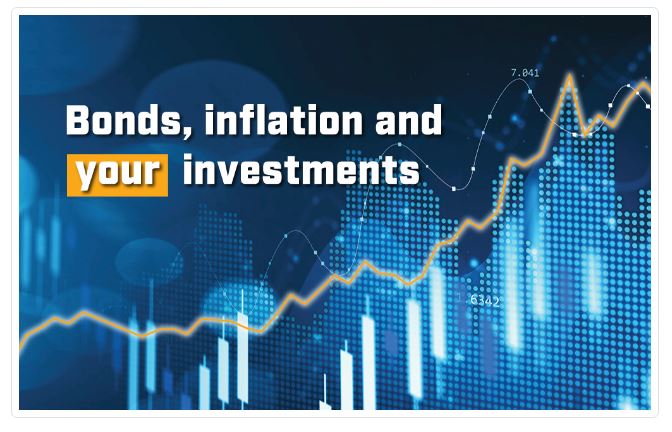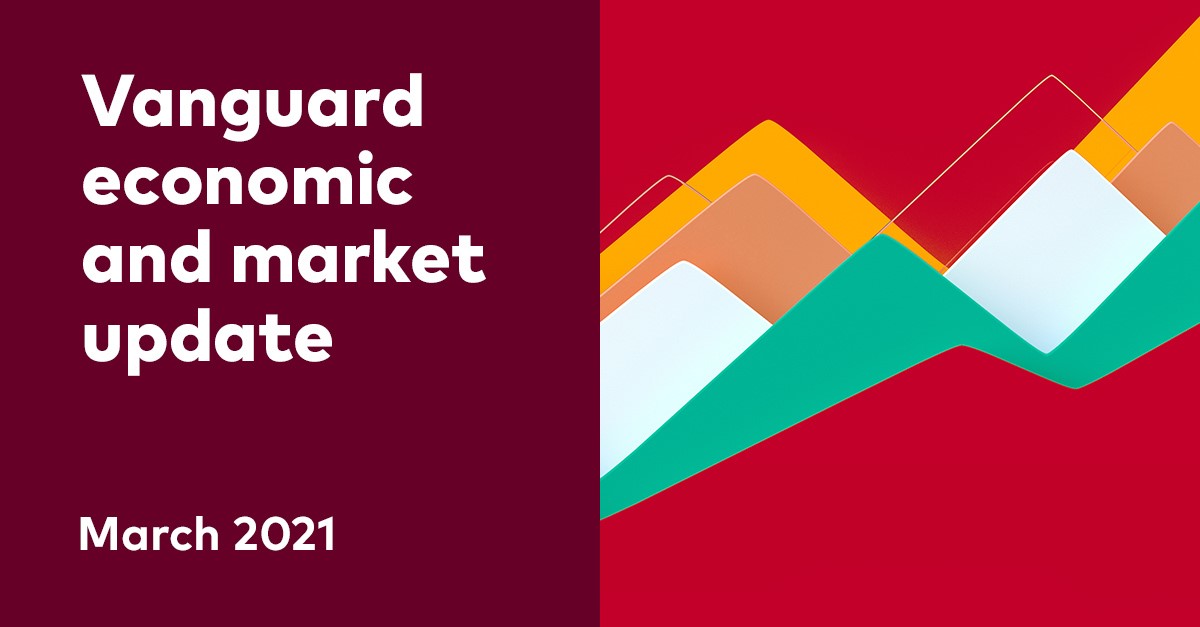2021 April Newsletter

April began with a welcome Easter break. As the vaccine rollout continues, restrictions ease, and life is a little closer to normal despite occasional setbacks. Whether you are relaxing at home, or heading off on holidays, we wish you and your family a happy Easter.
There was a raft of positive economic news in March, which should make the Federal Treasurer’s job a little easier when he hands down the Budget on May 11. The Australian economy staged a remarkable V-shaped recovery in 2020, growing 3.1% in the December quarter and 3.4% the previous quarter – the biggest 6-month lift on record - after plunging into recession in the first half year. The main contributor was iron ore, which has doubled in price since March last year.
As the vaccine rollout began and restrictions eased, business and consumer confidence rebounded. The NAB Business Confidence Index rose to an 11-year high of +16.4 points in February while the ANZ-Roy Morgan Consumer Confidence rating hit a 7-year high of 124 points in March, up 30% over the year.
Confidence was reflected in a recent surge in new vehicle sales, housing construction and property values. It was also boosted by a fall in unemployment from 6.4% to an 11-month low of 5.8% in February. Company profits have also remained strong, with 86% of ASX200 companies reporting a profit in the December half year. Although aggregate earnings fell 17%, dividends were up 5% on a year ago with an estimated $26 billion currently flowing to shareholders.
It’s not all plain sailing though. Temporary coronavirus JobSeeker and JobKeeper payments ended on March 31, and fuel prices are rising. The strengthening economy saw the Aussie dollar shed 2c to US76c in March.
Taking a break - a win for you and the economy
 2021 is shaping up to be a much more positive year than 2020 in so many ways. For people who put holiday plans on hold or those with itchy feet because they haven’t had much of a break for a while, this year is the year to get out and about.
2021 is shaping up to be a much more positive year than 2020 in so many ways. For people who put holiday plans on hold or those with itchy feet because they haven’t had much of a break for a while, this year is the year to get out and about.While overseas jaunts are off the table for some time to come, Australia’s management of the pandemic means we are able to head off and explore the local sights, while helping local communities and industries hit hard by 2020.
Recently the Australian Government announced their latest stimulus package for these industries, with $1.2 billion allocated to help our domestic tourism and aviation sectors.i
From 1 April 2021, there will be 800,000 half-priced flights available to 13 key regions which includes the Gold Coast, Cairns, the Whitsundays and Mackay region, the Sunshine Coast, Lasseter and Alice Springs, Launceston, Devonport and Burnie, Broome, Avalon, Merimbula and Kangaroo Island.
It’s also worth keeping your eye out for state run initiatives in the form of travel voucher schemes. While the amounts offered and conditions vary from state to state, they generally enable you to wine, dine or stay the night in a location with part of your bill subsidised.
The importance of R&R
There’s nothing like a holiday to help us feel more relaxed and give us a break from our everyday lives, something we very much need after the year that was.We know that having a break, whether it be from work or just our regular routines, tends to improve our wellbeing. It can offer a circuit breaker from some of your stressors, give you a new perspective as you take in new surroundings, lighten your mood as you do things you enjoy, give you a chance to spend some quality time with loved ones and simply recharge your batteries by sleeping in and taking it easy.
Supporting local
Perhaps you had to cancel that trip to Paris or have to let go the idea of relaxing on a beach in Bali. Fortunately, we are spoiled for choice when it comes to travelling in Australia, whether it’s a beach holiday you are after, a hike in the mountains, a trip to the snow, a tour of the outback or a foray into a rainforest. We are blessed with a myriad of natural wonders as well as vibrant cities with world class restaurants, attractions and nightlife. Not only will you have a wonderful time, you can also feel good about supporting businesses who need a hand getting back on their feet.While it can seem like a distant memory due to the COVID-19 outbreak, 2020 was also a hard time for many Australians due to the bushfires that ravaged many parts of the country. As a result, the locations affected are needing to rebuild and welcome tourists back, so why not give them a visit.
Planning your trip
Whether you take advantage of the flight specials or instead travel by bus, train or car, seeing another part of the country will give you something to look forward to.While we may have become nervous about forward planning due to the uncertainty of 2020, being organised will enable you to make the most of travel deals and plan your itinerary so you can fit in everything you want to do.
If you’re concerned about travelling at the present time, why not take the road less travelled and head to a private spot (perhaps an Airbnb rather than a busy hotel) in a destination that isn’t as well-known. By avoiding popular travel periods such as the school holidays, you will also avoid the crowds.
Wherever you travel in Australia, whether it’s to the other side of the country or just down the road, we hope you enjoy your well-deserved break and are able to recharge your batteries for what is shaping up to be an exciting year ahead.
Making a super split
 decoupling your superannuation?
decoupling your superannuation?In years gone by, superannuation was not treated as matrimonial property, so divorce settlements typically saw the woman keeping the house as she generally had the children and the man keeping his super. In a sense, neither party won. She ended up with a house but no money for her retirement while he had nowhere to live but money for his later years.
To remedy this situation, since 2002 super can be included when valuing a couple’s combined assets for a divorce settlement. After all, these days super is probably your second largest asset after your family home.
While super is counted in the calculation of the total property, that does not mean it is mandatory to split the super – the choice is yours.
Unlike the early 2000s, both partners are likely to have superannuation these days although traditionally women will still tend to have lower balances.i On average, women retire with just over half the super balance of men and 23 per cent of women retire with no super at all.
As a result, many divorcing couples may end up splitting super along with their other property.
How to split your super
If you decide to split your super, then you have three avenues, but keep in mind that all require legal advice.The three ways to split your super are:
- A formal written agreement that both you and your partner instruct a lawyer stating you have sought independent advice,
- A consent order, or
- A court order.
You can split your super as you choose both in terms of the amount and the timing. You can split it as a percentage or as an agreed figure and you can choose to split it immediately or at some time in the future. Much will depend on each of your life stages.
But whatever you decide, you MUST comply with the superannuation laws. Money received from your partner’s super must be kept in super unless you satisfy a condition of release. You also need to be mindful of taxable and non-taxable components and divide them equally.
How does it work?
Say the superannuation balances of a couple is $500,000 with John having $400,000 and Susie $100,000. If the property settlement on divorce was decided as a straight 50:50 split and it included the super, then John would need to give $150,000 of his super to Susie.Susie would nominate a fund and the money would be transferred.
If you have a binding financial agreement or a court order, this transfer of assets from one fund to another will not trigger a CGT event. But if you don’t have such an agreement, then John would trigger a CGT event on the $150,000 he transferred. Susie, meanwhile, would have the advantage of resetting the cost base on her received $150,000. So, a win for Susie, but not for John.
If John happened to be in the pension phase but Susie was still too young, the money that is transferred from his super to Susie will be treated according to his situation. As a result, Susie would be able to access the money before she reached preservation age.
What about SMSFs?
If you have a self-managed super fund, the situation could get a little more complicated as you have to deal with the issue of trusteeship.If there are only two members/trustees in the fund and Susie chose to leave, then John would either have to find a new trustee within six months or change to a corporate trustee where he could be the sole director.
Assets within an SMSF can also prove an issue, particularly if a sizeable proportion of the fund was tied up in a single asset such as commercial premises. How easy would it be to actually sell the premises? What if the property was John’s business premises and the means by which John was in a position to pay Susie child support? These are questions that need addressing.
If you are in the process of divorce or considering it, why not call us to help you plan your finances before and after the event.
Bonds, inflation and your investments
 The recent sharp rise in bond rates may not be a big topic of conversation around the Sunday barbecue, but it has set pulses racing on financial markets amid talk of inflation and what that might mean for investors.
The recent sharp rise in bond rates may not be a big topic of conversation around the Sunday barbecue, but it has set pulses racing on financial markets amid talk of inflation and what that might mean for investors.US 10-year government bond yields touched 1.61 per cent in early March after starting the year at 0.9 per cent.i Australian 10-year bonds followed suit, jumping from 0.97 per cent at the start of the year to a recent high of 1.81 per cent.ii
That may not seem like much, but to bond watchers it’s significant. Rates have since settled a little lower, but the market is still jittery.
Why are bond yields rising?
Bond yields have been rising due to concerns that global economic growth, and inflation, may bounce back faster and higher than previously expected.While a return to more ‘normal’ business activity after the pandemic is a good thing, there are fears that massive government stimulus and central bank bond buying programs may reinflate national economies too quickly.
The risk of inflation
Despite short-term interest rates languishing close to zero, a sharp rise in long-term interest rates indicates investors are readjusting their expectations of future inflation. Australia’s inflation rate currently sits at 0.9 per cent, half the long bond yield.To quash inflation fears, Reserve Bank of Australia (RBA) Governor Philip Lowe recently repeated his intention to keep interest rates low until 2024. The RBA cut official rates to a record low of 0.1 per cent last year and launched a $200 billion program to buy government bonds with the aim of keeping yields on these bonds at record lows.iii
Governor Lowe said inflation (currently 0.9 per cent) would not be anywhere near the RBA’s target of between 2 and 3 per cent until annual wages growth rises above 3 per cent from 1.4 per cent now. This would require unemployment falling closer to 4 per cent from the current 6.4 per cent.
In other words, there’s some arm wrestling going on between central banks and the market over whose view of inflation and interest rates will prevail, with no clear winner.
What does this mean for investors?
Bond prices have been falling because investors are concerned that rising inflation will erode the value of the yields on their existing bond holdings, so they sell.For income investors, falling bond prices could mean capital losses as the value of their existing bond holdings is eroded by rising rates, but healthier income in future.
The prospect of higher interest rates also has implications for other investments.
Shares shaken but not stirred
In recent years, low interest rates have sent investors flocking to shares for their dividend yields and capital growth. In 2020, US shares led the charge with the tech-heavy Nasdaq index up 43.6%.ivIt’s these high growth stocks that are most sensitive to rate change. As the debate over inflation raged, the so-called FAANG stocks – Facebook, Amazon, Apple, Netflix and Google - fell nearly 17 per cent from mid to late February and remain volatile.v
That doesn’t mean all shares are vulnerable. Instead, market analysts expect a shift to ‘value’ stocks. These include traditional industrial companies and banks which were sold off during the pandemic but stand to gain from economic recovery.
Property market resilient
Against expectations, the Australian residential property market has also performed strongly despite the pandemic, fuelled by low interest rates.National housing values rose 4 per cent in the year to February, while total returns including rental yields rose 7.6 per cent. But averages hide a patchy performance, with Darwin leading the pack (up 13.8 per cent) and Melbourne dragging up the rear (down 1.3 per cent).vi
There are concerns that ultra-low interest rates risk fuelling a house price bubble and worsening housing affordability. In answer to these fears, Governor Lowe said he was prepared to tighten lending standards quickly if the market gets out of hand.
Only time will tell who wins the tussle between those who think inflation is a threat and those who think it’s under control. As always, patient investors with a well-diversified portfolio are best placed to weather any short-term market fluctuations.
If you would like to discuss your overall investment strategy, give us a call.
i Trading economics, viewed 11 March 2021, https://tradingeconomics.com/united-states/government-bond-yield
ii Trading economics, viewed 11 March 2021, https://tradingeconomics.com/australia/government-bond-yield
iii https://www.reuters.com/article/us-oecd-economy-idUSKBN2B112G
iv https://www.smh.com.au/politics/federal/growth-prospects-for-australia-and-world-upgraded-by-oecd-20210309-p57973.html
v https://rba.gov.au/speeches/2021/sp-gov-2021-03-10.html
vi https://www.washingtonpost.com/business/2020/12/31/stock-market-record-2020/
vii https://www.corelogic.com.au/sites/default/files/2021-03/210301_CoreLogic_HVI.pdf
Vanguard economic and market update - March 2021

Key points
- Economic growth levels across most developed countries are increasing, supported by major fiscal stimulus programs and the ongoing rollout of COVID-19 vaccinations.
- On a monetary policy level, central banks are leaving official interest rates unchanged and in some cases increasing purchases of government bonds to counter higher longterm yields.
- Headline inflation levels are expected to rise gradually in key markets, but longer-term structural trends will likely limit the extent of consumer price rises.
- Employment trends remain mixed, in line with the pace of recovery in specific countries as they deal with the impacts of the pandemic.
Economic growth
With the passage of the US$1.9 trillion American Rescue Plan Act of 2021 on March 11, Vanguard foresees the United States economy growing in a range of 7% to 7.5% for all of 2021, an increase of 2 to 2.5 percentage points compared to what our projection would have been without the new stimulus.
We expect first-quarter growth to be modestly above 5% as most Americans receive stimulus payments, and that the current pace of COVID-19 vaccination will support a significant pickup in economic activity in the second half of the year.
A slower pace of COVID-19 vaccinations puts the euro area behind both the United Kingdom and the U.S. on that front and increases the risks related to its timetable for easing COVID-19 restrictions. We foresee euro area GDP growth around 5% for 2021, with GDP reaching its pre-pandemic level in the next 12 months or so.
GDP in the United Kingdom is estimated to have fallen by –2.9% in January, attributable to restrictions related to COVID-19. The services sector, which contracted by –3.5%, bore the brunt of the effect. But better days appear to be ahead as case numbers fall, the pace of vaccination increases, and restrictions are expected to be lifted by the end of the second quarter. Although we expect a first-quarter contraction in activity, we foresee a meaningful economic rebound in the second and third quarters and full-year 2021 growth around 6%.
In China, robust industrial production and exports offset moderate weakness in consumption in January and February. The resilience in the economy is bringing consensus estimates for China's full-year 2021 growth closer to Vanguard's forecast around 9%. At the annual National People's Conference in early March, Chinese officials set a 6% growth target for the year and a goal of doubling the size of the economy by 2035, which implies average annual growth around 4.7%.
GDP rose more than expected in the fourth quarter in Australia, by 3.1% compared with the third quarter on a seasonally adjusted basis, topping consensus estimates of 2.5%. The more solid base makes Vanguard more optimistic about prospects for Australia's growth in 2021; we now foresee growth for the full year around 5%, and the economy reaching its full potential by the second half of 2022. Full-year 2020 growth came in at negative 2.4%.
Vaccine breakthroughs and rollouts in developed economies make Vanguard optimistic that emerging markets on aggregate will grow by more than the 6% outlook we communicated at the end of 2020. We continue to see emerging Asia lead the way, with 2021 growth above 8%. The region's pandemic management continues to bear fruit and export-driven models are benefiting as global recovery takes hold.
Monetary policy
The U.S. Federal Open Market Committee voted on March 17 to leave the target range for its federal funds rate unchanged at 0%–0.25% and its bond-buying program unchanged. Vanguard foresees a potential third-quarter 2023 lift-off for the Fed's rate target. We believe the Fed would need to see substantial progress toward achieving its dual mandate of stable prices and maximum employment, which Fed governors saw as being some time off, before slowing its US$120 billion per month in purchases of U.S. treasuries and agency mortgage-backed securities.
The European Central Bank (ECB) left its key rates intact at its March 11 policy meeting but signalled a "significantly higher pace" of asset purchases under its Pandemic Emergency Purchase Programme (PEPP). The unspecified increase in bond-buying is intended to counter rising borrowing costs within a European Union still struggling with the health and economic effects of COVID-19. Vanguard expects that the ECB will increase its purchases from around €12 billion per week to around €20 billion per week to counter higher yields on longer-dated bonds.
The Bank of England (BOE) maintained its bank rate at 0.1% at its March 17 Monetary Policy Committee meeting and left its UK government bond purchase program target unchanged at £875 billion. The BOE noted that global GDP growth had been stronger than anticipated since its last meeting. We expect the bank's asset purchases to continue through the end of 2021, with an increase in the bank rate likely only a year later.
The Reserve Bank of Australia (RBA) left its cash rate and three-year government bond target intact at 0.10% at its March 2 policy meeting. The RBA reiterated it was unlikely to raise the cash rate until 2024, the earliest it foresees actual inflation sustainably within its 2% to 3% target. For that to occur, the RBA said, significant gains in employment and a return to a tight labour market would be required to push wages higher.
Policymakers in China are likely to recalibrate policy in their effort to stem gains in debt-to-GDP levels and to ward off financial bubbles. Vanguard expects China to gradually withdraw both monetary and fiscal support to achieve these aims. On the fiscal side, the government will aim to reduce its official fiscal deficit target from 3.6% to 3.2% in 2021. On the monetary side, policymakers will aim to slow credit growth, though in our view the People's Bank of China will refrain from outright policy rate hikes this year.
Vanguard expects central banks in emerging markets to continue to maintain an easy monetary policy, but rising yields in the United States could constrain that effort to a degree.
Inflation
The Consumer Price Index (CPI) in the U.S. rose 0.4% in February on a seasonally adjusted basis compared with January, with petrol prices accounting for more than half the rise. Core CPI, which removes volatile food and energy prices, rose just 0.1%. Compared with a year earlier, the broad price index rose 1.7%, while core prices were up by 1.3%. Vanguard expects core U.S. inflation to surpass 2% in the coming months as base effects—comparisons to low year-earlier numbers—magnify price rises as people re-engage in face-to-face activities. But we expect the rise above 2% to be short-lived, and that long-term structural trends that have kept inflation low for more than a decade will continue to limit price rises.
Headline inflation rose by 0.9% in the euro area in February on an annual basis, unchanged from January, according to the final estimate from Eurostat, the European Union's statistical agency. Underlying price pressures remain subdued amid weak labour bargaining power and low inflation expectations. We expect core inflation to gradually rise toward 1.5% as the pace of economic recovery increases in the second half of the year, with occasional upside volatility owing to supply-chain bottlenecks related to Brexit and a global semiconductor shortage.
Vanguard expects both headline and core inflation in the UK to rise toward the Bank of England's 2% target over the next year as the effects of lower energy prices unwind and the economy strengthens. Headline inflation rose by 0.7% in January compared with a year earlier, up from a 0.6% rise in December.
Despite some modest base effects, or comparisons to low year-earlier prices, Vanguard doesn't expect core inflation in Australia to approach the RBA's 2% to 3% target range anytime soon. We expect that spare capacity in the broad economy and in the labour market will leave core inflation around 1.5% by year's end, higher than the RBA's forecast of 1.25%.
Vanguard expects core consumer prices in China to strengthen in the second quarter as activity normalises further. We expect higher commodities prices to feed into producer prices, but pass-through effects to consumers may be capped. Consumer prices rose by 0.6% in February compared with January but were down – 0.2% compared with February 2020. The Producer Price Index rose 1.7% in February compared with a year earlier, and 0.8% compared with January.
Emerging markets continue to diverge, with disinflation (inflation well below target), a concern in parts of Southeast Asia, notably Indonesia and the Philippines.
Employment
The unemployment rate in the U.S. fell slightly in February, to 6.2% compared with 6.3% in January, while the U.S. labour market added 379,000 jobs. Vanguard foresees the headline unemployment rate falling toward 5% by year's end, and into the low 4% range, closer to pre-pandemic levels, by the end of 2022.
Unemployment in the euro area was 8.1% in January 2021 on a seasonally adjusted basis, unchanged from a revised 8.1% in December 2020, and up from 7.4% in January 2020. The unemployment rate in the UK rose to 5.1% in the three months ended in December 2020, up slightly from 5.0% a month earlier and a sixth straight month of increase.
The unemployment rate in Australia fell to 5.8% in February from a revised 6.3% in January. Despite relatively upbeat recent labour market reports, Vanguard doesn't expect Australia will reach full employment, which the RBA has suggested it would consider to be around 4.5%, before 2022.
Asset class returns
Our 10-year annualised nominal return projections are as follows.
|
Asset class |
Median volatility |
10-year annualised return forecast |
|
Australian equities |
21.0% |
4.7%-6.7% |
|
Global ex-Australia equities (unhedged) |
19.4% |
4.3%−6.3% |
|
Australian aggregate bonds |
4.6% |
0.6%−1.6% |
|
Global bonds ex-Australia (hedged) |
3.1% |
0.9%-1.9% |
|
|
||
IMPORTANT: The projections or other information generated by the Vanguard Capital Markets Model regarding the likelihood of various investment outcomes are hypothetical in nature, do not reflect actual investment results, and are not guarantees of future results. Distribution of return outcomes from the VCMM are derived from 10,000 simulations for each modelled asset class. Simulations are as of September 30, 2020. Results from the model may vary with each use and over time.
Please note this information is of a general nature only and has been provided without taking account of your objectives, financial situation or needs. Because of this, we recommend you consider, with or without the assistance of a financial advisor, whether the information is appropriate in light of your particular needs and circumstances.
Copyright in the information contained in this site subsists under the Copyright Act 1968 (Cth) and, through international treaties, the laws of many other countries. It is owned by EFDB Pty Ltd unless otherwise stated. All rights reserved. You may download a single copy of this document and, where necessary for its use as a reference, make a single hard copy. Except as permitted under the Copyright Act 1968 (Cth) or other applicable laws, no part of this publication may be otherwise reproduced, adapted, performed in public or transmitted in any form by any process without the specific written consent of EFDB Pty Ltd.
Categories
- Blogs (51)
- Budget (19)
- Community and Sponsorships (5)
- Cyber Security (3)
- Economic / Topical (36)
- End of Financial Year (8)
- Estate Planning (4)
- Foreign Exchange (1)
- Gifting (2)
- Health (16)
- Insurances (18)
- Investments (29)
- Lifestyle (41)
- Newsletters (55)
- Retirement (19)
- Share Buyback (1)
- Superannuation (27)
Recent Posts
Archives
- November 2022 (1)
- May 2022 (1)
- April 2022 (1)
- February 2022 (1)
- December 2021 (1)
- November 2021 (1)
- September 2021 (1)
- June 2021 (1)
- May 2021 (1)
- April 2021 (1)
- March 2021 (1)
- February 2021 (1)
- January 2021 (1)
- December 2020 (1)
- October 2020 (1)
- September 2020 (1)
- August 2020 (1)
- July 2020 (1)
- June 2020 (1)
- May 2020 (1)
